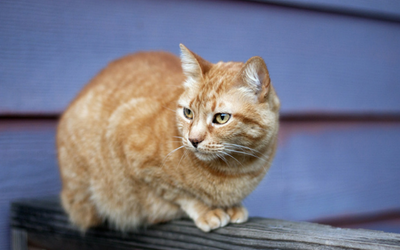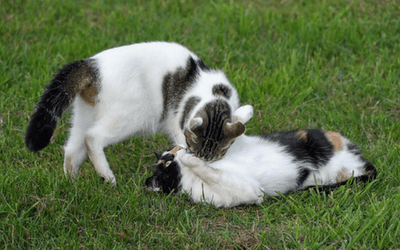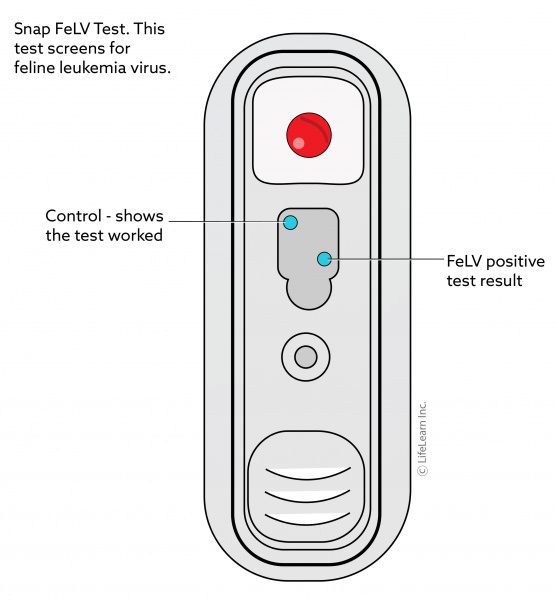How Long Does The Feline Leukemia Leukemia Virus Lives Off Of The Animal
What is feline leukemia virus (FeLV)?
Feline leukemia virus (FeLV) is a virus that infects cats. Information technology was beginning discovered in cats with a grade of leukemia (cancer of the white claret cells). FeLV can crusade a variety of diseases in addition to leukemia. Like all viruses, FeLV is a tiny microorganism that can only replicate itself inside living cells. FeLV is specific to members of the cat family and does non pose a risk to other species of animals or people.
How common is FeLV? 
FeLV infection is found worldwide. In general, effectually 1-2% of the true cat population is persistently infected with this virus, and many more are exposed. The number of cats infected differs according to the geographical location, environment, and the lifestyle of the cat. Infection is more common in colonies of cats where there is shut contact between individuals.
What affliction does the virus crusade?
FeLV invades diverse cells of the cat'southward immune system and blood-forming tissues. Invasion into the prison cell leads to death of the cell or a mutation (alter) in the cell's genetic code. Such a change can make the cell potentially cancerous, although this change may not occur for months to years after infection.
Cancers can occur in a multifariousness of tissues, organs, and trunk sites due to FeLV. Such cancers can involve any blazon of the circulating white blood cells (leukemia) or other cells of the blood-forming tissues. The most mutual tumor associated with FeLV is that of lymphoid cells known equally lymphoma or lymphosarcoma (come across handout "Lymphoma in the Cat"). These tumors may occur at single or multiple sites in the trunk.
Although the development of cancer is one upshot of FeLV infection, other diseases are more mutual. In many cats, FeLV infection results in a moderate to severe suppression of the allowed arrangement. This means that the infected cat is less able to defend itself confronting a wide range of infections that would not normally cause a trouble in healthy cats. Affected cats may develop various clinical signs, and there is a progressive deterioration in their health over fourth dimension.
Another common occurrence in FeLV-infected cats is the development of life-threatening anemia (low red blood cells). Other bug, including ballgame, astringent enteritis (intestinal inflammation), neurological (nerve) disease, and ocular (middle) illness are commonly associated with FeLV infection.
FeLV is usually fatal. Studies have shown that 80-90% of FeLV-infected cats will die within iii to four years of initial diagnosis.
How is FeLV transmitted?

"Direct contact between cats is the most frequent method of FeLV infection."
Another potential source of infection occurs when a pregnant cat infected with FeLV gives birth. In this situation, the kittens may exist born with FeLV virus or, more likely are infected when their mother grooms them. Even so, most queens infected with FeLV are infertile or there is pre-natal death of the kittens with abortion or resorption of the fetuses.
What happens when a true cat is exposed to FeLV?
Not all cats exposed to FeLV will develop persistent infections. The allowed arrangement of many infected cats responds to the virus, and near xxx% of these cats successfully eliminate the virus. However, until the infection is cleared, these cats carry the virus and damage can exist done during this time that may lead to disease subsequently in life.
Approximately lxx% of cats are unable to mount an effective immune response and eliminate the virus. Following infection, these cats become persistently and permanently infected with the virus and are at the highest chance of developing FeLV- related disease. It is these permanently infected cats that are primarily responsible for the transmission of FeLV to other cats. It can exist many months or fifty-fifty years betwixt the initial virus infection and the onset of related clinical illness bug. During this time, virus particles may exist continuously shed in the cat'south saliva.
How tin can FeLV infection be diagnosed? 
Diagnosis of FeLV infection is relatively simple. A rapid blood test tin can be performed which is able to detect parts of the virus in the claret of an infected cat. This exam is very authentic and reliable, although false results may rarely occur. Some cats with only a transient FeLV infection (those cats that are able to mount an effective immune response) will be positive on the initial blood test. A second examination performed eight to twelve weeks later the first test may be required to differentiate between temporary and persistent infections. In some situations, information technology may be necessary to ostend infection through additional blood testing at a specialized laboratory.
"Diagnosis of FeLV infection is relatively simple."
Diagnosis of disease due to FeLV is more than difficult considering of the multifariousness of signs and symptoms. It is mutual to have a complicated situation in which other diseases or atmospheric condition occur alongside the FeLV infection.
Is at that place any handling for FeLV infection or disease?
At that place is currently no specific treatment for FeLV-infected cats. In that location is no treatment to eliminate the virus from the torso. Near FeLV-infected cats will eventually dice or require humane euthanasia due to diseases related to their infection. However, many cats showing FeLV-related illness will improve with symptomatic treatment, at to the lowest degree temporarily. For example, if FeLV is causing immunosuppression and the patient develops secondary infections, the secondary infections may be treatable, leading to clinical improvement.
How can infection exist prevented?
Vaccines are available to protect cats against FeLV infection. Their employ is highly recommended for whatever adult true cat that goes outside at whatsoever fourth dimension and therefore could have contact with FeLV-infected cats. As with other vaccines, an initial class of two injections is required, and regular boosters are necessary to maintain immunity. Your veterinarian will discuss the near appropriate vaccination options for your true cat with you. All cats should be tested for FeLV prior to vaccination, and all kittens should exist vaccinated for FeLV regardless of lifestyle.
Although vaccination is very helpful in preventing infection with FeLV and therefore decision-making FeLV-related disease, no vaccine is 100% protective. Do not allow your cat to roam. When possible, practice not allow your cat, particularly equally a kitten, to come into close contact with known FeLV-infected cats or cats without a known history of proper vaccinations.
"Vaccinating a cat does not interfere with futurity claret testing for FeLV."
In larger colonies of cats, it is possible to control FeLV infection through a combination of routine FeLV testing, quarantine, and vaccination programs. Fortunately, vaccinating a true cat does not interfere with time to come blood testing for FeLV.
Source: https://vcahospitals.com/know-your-pet/feline-leukemia-virus-disease-complex
Posted by: hardinhiplent79.blogspot.com

0 Response to "How Long Does The Feline Leukemia Leukemia Virus Lives Off Of The Animal"
Post a Comment